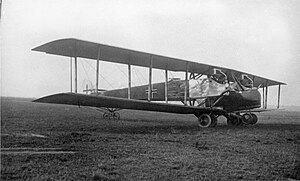Siemens-Schuckert L.I
| L.I | |
|---|---|

| |
| Role | Heavy bomber aircraft
|
| National origin | Germany |
| Manufacturer | Siemens-Schuckert |
| First flight | 1918 |
| Number built | 3 |
The Siemens-Schuckert L.I was a large, three-engined
twin boom design, strongly influenced by the successful Caproni Ca.3
. Three were built but not used operationally.
Design and development
In 1918 Idflieg ordered a bomber which was to follow the layout of the three engine, twin boom Italian Caproni designs. It was originally called the G.III but was eventually moved into a new L category, intermediate between G and R,[1] the only aircraft ever to be so classified.[2]
The L.I was a large biplane with a wingspan of 32 m (105 ft). The wing was straight edged and of constant
The L.I was flown from a
conventional undercarriage had pairs of mainwheels mounted under each outer engine and a tailskid on each boom. It also had a substantial nosewheel, mounted on the nacelle, to protect the L.I from damaging noseovers.[1][2]
Three L.Is were built but the type was not used operationally.[1]
Specifications
Data from German Aircraft of the First World War.[1]
General characteristics
- Crew: Four
- Length: 14.65 m (48 ft 1 in)
- Wingspan: 32 m (105 ft 0 in)
- Wing area: 169 m2 (1,820 sq ft)
- Empty weight: 4,400 kg (9,700 lb)
- Gross weight: 6,400 kg (14,110 lb)
- Powerplant: 3 × Maybach Mb.IV 6 cylinder water cooled inline, 180 kW (240 hp) each
- Propellers: 2-bladed . Two pusher
Performance
- Maximum speed: 125 km/h (78 mph, 67 kn)
- Endurance: 5.5 hr
Armament
- Guns: 3 × Parabellum MG14 machine guns
See also
References
Wikimedia Commons has media related to Siemens-Schuckert L.I.
- ^ ISBN 0-85177-809-7.
- ^ a b c Grosz, Peter M.; Kruger, Egon (March 1958). "Siemens-Schuckert aircraft 1909–19, part II". Air Pictorial. Vol. XX, no. 3. p. 78.
